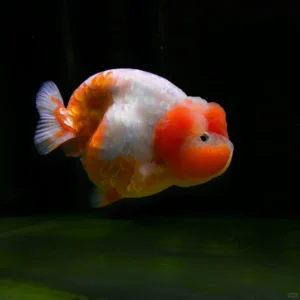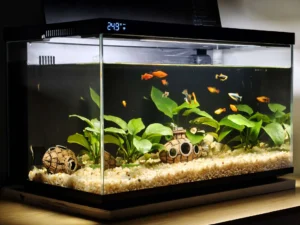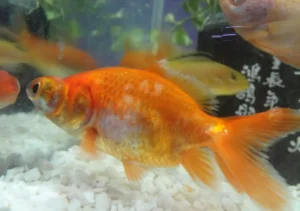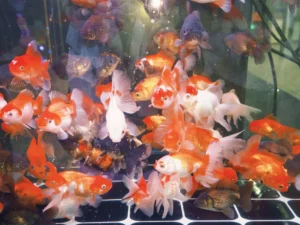Keeping goldfish healthy and active depends largely on clean, well-oxygenated water. A properly chosen goldfish tank filter ensures that waste, uneaten food, and harmful toxins are removed from the aquarium. However, simply installing a filter isn’t enough—you also need to calculate the right flow rate to match the size of your goldfish tank.
In this article, we’ll explain what flow rate means, how to calculate it for a goldfish tank filter, and why getting it right is so important. We’ll also answer common FAQs to help goldfish owners make informed decisions.

What Is Flow Rate in a Goldfish Tank Filter?
The flow rate refers to how much water your filter can process within a given time, usually measured in gallons per hour (GPH) or liters per hour (LPH).
- A high flow rate means the water circulates quickly, which is good for removing debris.
- A low flow rate may not be enough to keep the tank clean, especially since goldfish produce a lot of waste.
The correct flow rate is essential to prevent cloudy water, ammonia spikes, and stress for your goldfish.
Why Flow Rate Matters for Goldfish
Goldfish are messy eaters and produce more waste than many tropical fish. Without an efficient goldfish tank filter, the water quality deteriorates quickly. Poor filtration can lead to:
- High ammonia and nitrite levels
- Cloudy, smelly water
- Increased risk of disease
- Reduced oxygen levels
By calculating the right flow rate, you ensure the filter can handle the tank’s bio-load and keep your goldfish healthy.
How to Calculate Goldfish Tank Filter Flow Rate
The general rule for goldfish tanks is that the filter should cycle the entire tank volume 4–10 times per hour. The exact number depends on the number of fish, their size, and the type of setup.

Step 1: Measure Your Tank Volume
A 20-gallon tank with two goldfish = 20 gallons total.
Step 2: Multiply by the Turnover Rate
Minimum: Tank Volume × 4
Maximum: Tank Volume × 10
For a 20-gallon goldfish tank:
Minimum flow rate = 20 × 4 = 80 GPH
Maximum flow rate = 20 × 10 = 200 GPH
That means you need a goldfish tank filter rated between 80–200 GPH.
Step 3: Consider Extra Waste Load
If you have multiple goldfish or a heavily stocked tank, lean toward the higher end of the range. For example, a 30-gallon tank with three goldfish should ideally have a filter around 250–300 GPH.
Factors That Affect Goldfish Tank Filter Flow Rate
Tank Size – Larger tanks require higher flow rates.
Number of Goldfish – More fish = more waste = stronger filter.
Filter Type
- Hang-on-back filters (HOB): Good for smaller tanks.
- Canister filters: Ideal for medium to large tanks, powerful and customizable.
- Sponge filters: Provide biological filtration, good for fry or hospital tanks.
Tank Setup – Heavy decorations, plants, or substrate can slow down circulation, requiring a stronger filter.
Signs Your Filter Flow Rate Is Too Low
- Cloudy water despite regular cleaning
- Uneaten food and debris settling at the bottom
- Ammonia or nitrite spikes in water tests
- Goldfish gasping for air at the surface
Signs Your Filter Flow Rate Is Too High
- Goldfish struggling to swim against strong currents
- Constant stress or hiding behavior
- Fins appearing frayed due to excessive water movement
Tips for Choosing the Right Goldfish Tank Filter
- Pick a filter that exceeds the minimum flow rate recommendation.
- Choose a filter with adjustable flow settings.
- Consider using two filters in larger tanks for balanced circulation.
- Clean and maintain your filter regularly to ensure consistent performance.

Frequently Asked Questions (FAQ)
1. How often should a goldfish tank filter cycle the water?
A goldfish tank filter should cycle the tank volume 4–10 times per hour, depending on stocking levels.
2. Can I use a tropical fish filter for goldfish?
Yes, but ensure the filter has a higher flow rate. Goldfish need more powerful filtration than tropical fish due to their waste output.
3. Do goldfish prefer strong currents?
No. While goldfish need clean water, too strong a flow can stress them. Choose a filter with adjustable flow or use decorations to break strong currents.
4. Should I use one large filter or two smaller ones?
Using two smaller filters can improve water circulation and provide backup if one filter fails.
5. How do I know if my goldfish tank filter is powerful enough?
Check water parameters weekly. If ammonia or nitrite levels rise, your filter may be underpowered.

Conclusion
Calculating the correct goldfish tank filter flow rate is essential for maintaining a clean, safe environment. Remember the basic rule: your filter should cycle the tank’s water volume 4–10 times per hour. By considering your tank size, number of goldfish, and filter type, you can select a filter that keeps your goldfish healthy and thriving.
A well-chosen goldfish tank filter not only improves water quality but also ensures your goldfish live longer, happier lives.




